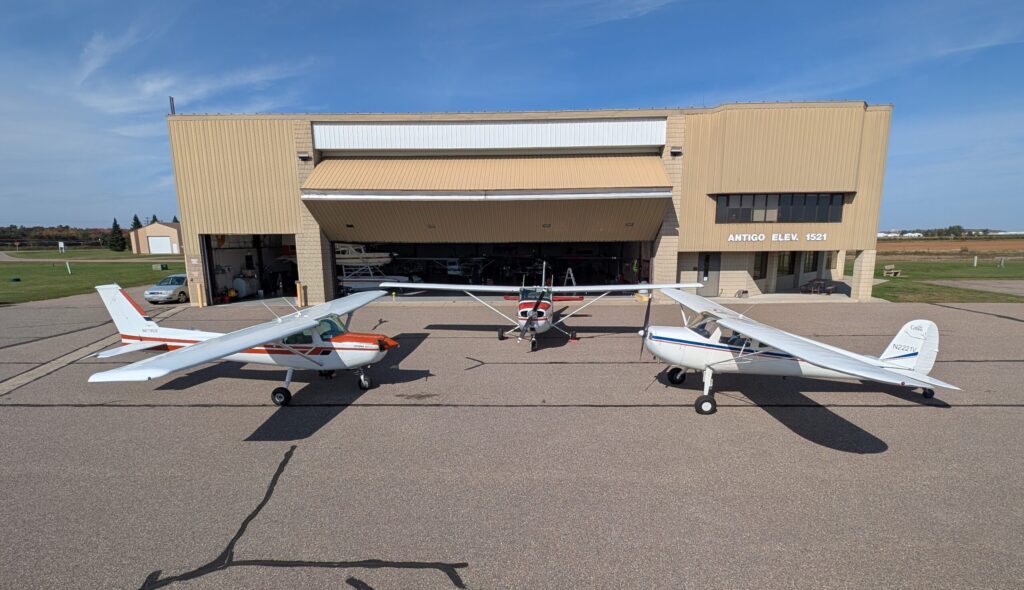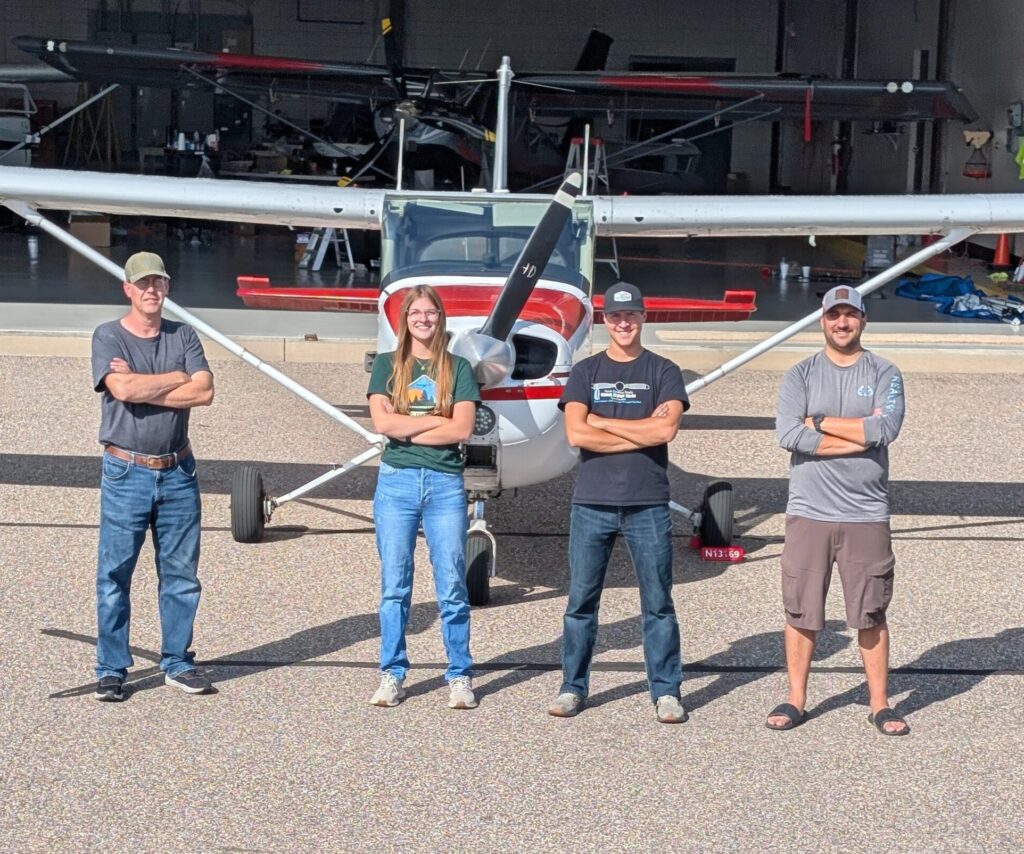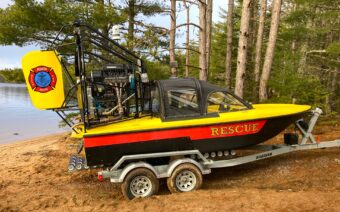
October 13, 2025
ANTIGO – When Northwoods Gateway Aviation took over field operations at Langlade County Airport four years ago, Director of Operations Alan Horzewski said things were quiet – too quiet.
Horzewski said there was no flight training available and aircraft maintenance on the field was minimal.
The team quickly stepped in to change that, he said, bringing much-needed services to the airport and breathing new life into its operations.
Horzewski, who has been with the company since its founding, said they’ve trained more students in the past two years than the airport saw in the entire previous decade.
He said he believes the growth is partly driven by a demand for pilots and increased interest from people looking to enter the aviation industry.
Horzewski said having a full-time mechanic on site has allowed them to maintain their training fleet, while also servicing the rising number of aircraft now based at the airport.
Rising interest across all ages
Horzewski said interest in learning to fly has surged in recent years, with students ranging in age from teenagers to those in their 60s.
A majority of students under 40, he said, are focused on earning multiple ratings – private, instrument, commercial or flight instructor – to establish an aviation career.
“Most of our younger people who have trained with us, those [in their] 20s and 30s, have aspirations to do more than just a hobby with it,” he said. “I haven’t had any of those people just get their private license. All of them have been working toward flying something bigger or faster in their lifetime.”
Whether aiming for commercial flying or military service, Horzewski said opportunities exist in both fields.
For younger trainees – particularly teens and those in their early 20s – Horzewski said flight training can provide a crucial stepping stone toward military service in branches like the U.S. Air National Guard or Air Force.
A pilot in the Air National Guard, Horzewski said having a private pilot license or flight experience is often an important part of military recruitment – giving candidates a solid understanding of aviation fundamentals and airmanship, which can open doors for future opportunities.
And though much of the interest comes from those 40 and under, Horzewski said he has also noticed a growing number of students in their 50s and 60s.
For many in this age group, he said, learning to fly is a bucket-list goal.
Levels of licenses
Horzewski said earning a pilot’s license isn’t quick or easy, even with many online training courses available – it requires dedication and persistence.
Typically, Horzewski said students can expect to spend around $10,000 and log 40-50 hours of flight time – 30 hours with a certified flight instructor and 10-15 hours solo – to obtain a private plane license.
And though that may seem like a significant investment, Horzewski said the potential to build a rewarding career in aviation makes it worthwhile.
Horzewski said with a private pilot license, one can fly passengers, but strictly for leisure – one can’t be paid for it.
Regulations, he said, also restrict flights to heights where the ground is clearly visible, forbidding flying through clouds.
Horzewski said the next step for pilots looking to advance and fly in a wider range of weather conditions is obtaining an instrument rating.
This rating, he said, is where pilots truly begin to develop the professionalism required in the field.
As a private pilot, Horzewski said much of a pilot’s time is spent flying in and out of small, uncontrolled airfields with limited communication with air traffic control – that changes significantly once they begin instrument training.
Horzewski said pilots work closely with air traffic controllers and are treated with the same level of coordination and oversight as commercial airliners arriving at major airports.
“It’s cool to watch students’ confidence grow into that role,” he said. “They get that professionalism. It usually takes another 40 hours to get this done, so once you’re done with this, you’ve logged about 100 hours of flying.”
The next step for students pursuing an aviation career, Horzewski said, is the commercial license, which allows pilots to start getting paid for flying.
Requiring a minimum of 250 total flight hours, this rating, he said, highlights the critical role of experience in pilot development.
“The FAA wants to make sure you get a plethora of experience,” he said. “There’s a lot of different stuff that we do in the training world to get you from private hobbyist to consummate professional at the commercial level.”
Horzewski said he finds it interesting that when people come in to start training, they may not realize how many jobs are in aviation.
Aviation, he said, offers many career paths beyond commercial or military pilots – from corporate and agricultural pilots to firefighting and Department of Natural Resources pilots.
And that’s just the flying jobs, Horzewski said.
Behind the scenes, he said roles like air traffic control, avionics and aircraft maintenance are just as important.
Charting the course
Though getting licensed as a pilot requires a lot of hard work and commitment, Horzewski said with determination, anything is possible.
This is exemplified, he said, by one of Northwoods Gateway Aviation’s employees, who began training with the company at just 16 years old and passed her commercial check ride before she finished high school.
Today, Horzewski said she works at Northwoods as a certified flight instructor (CFI).
“It’s a cool full-circle [example],” he said.
Horzewski said having someone so young on staff has been valuable for Northwoods, as it allows them to better understand how younger students think and learn, which benefits everyone involved.
Though he is only 30, Horzewski said the technology has changed immensely since he went through flight training 12-13 years ago.
“Avionics, glass cockpit, iPads – those weren’t really a thing,” he said. “We were using paper charts and paper maps. These days, it’s more technology-savvy airplanes and technology-savvy instructors, which makes things much easier.”

Though Northwoods operates several types of training aircraft, Horzewski said the main plane for private pilot instruction combines the classic “six-pack” cockpit instruments – airspeed indicator, altimeter, vertical speed indicator, altitude indicator, heading indicator and turn coordinator – with GPS as a safety feature.
Horzewski said the rationale behind this training approach is simple: if pilots can master the traditional “six-pack” instruments, transitioning to newer digital technology becomes much easier.
“I think it’s helpful to start with the ‘old style’ because then you can always fall back on those principles,” he said. “We actually have both and train students as students run through their progression from private to instrument to commercial.”
In addition to the hands-on learning, Horzewski said there are many online videos and training resources available.
Though these serve as a useful introduction, Horzewski said achieving the level of understanding required to be a pilot requires in-depth, instructor-led teaching.
Northwoods, he said, uses technology to supplement and reinforce the instruction provided by its CFIs.
Training flexibility
Horzewski said one of the biggest advantages of training with Northwoods is that it operates as a Part 61 school, instead of a Part 141 school.
Where Part 61 schools differ from Part 141 schools – which resemble college programs – Horzewski said, is in the flexibility it offers.
For example, he said, if a student is only available on specific days and times – especially in Wisconsin, where the weather can be unpredictable – “we’re flexible.”
“We’re able to take our curriculum and move it throughout different parts, whatever the weather and time allow,” he said.
Furthermore, Horzewski said the Part 61 training environment offers a much more personalized, one-on-one experience.
In contrast, he said Part 141 often involves working with multiple instructors, which, in his experience, can sometimes lead to confusion for students.
Northwoods’ style of education, Horzewski said, fosters one-on-one familiarity with an instructor – a consistency that allows the instructor to identify and address developing trends in the student’s progress more effectively.
Affordability, he said, is another plus of training at Northwoods – as its airplane options are cheaper to rent.
With rental options, such as the Cessna 152, Horzewski said students can fly a reliable but less expensive aircraft compared to the typical Cessna 172.
Many pilots, he said, take advantage of this after earning their private license, cutting rental costs by $30-50 per flight.
“You add that up over a couple hundred hours and that makes a big difference,” he said. “We’re happy to be able to offer that.”
Though the Fly Wisconsin passport program isn’t unique to Northwoods, Horzewski praised the Wisconsin Bureau of Aeronautics for creating it.
The program, he said, is a fun way to encourage pilots to explore airports across the state while enjoying a variety of scenery – forests, fields, lakes and towns – and learning how each environment connects with the local airports.
On top of that, Horzewski said it’s a great way to build flight hours.
Next-gen professionals
As interest in aviation careers continues to rise – with a lot more people his age and younger working at airports – Horzewski said getting the youth involved at an early age is essential.
Training the next generation of aviation professionals, he said, is crucial to avoiding shortages – especially of pilots and air traffic controllers, both vital positions within the industry.
“Obviously, it’s challenging, it’s not a cheap endeavor, but we try to get involved in events at airports where people have fly-ins, car shows, pancake breakfasts and more,” he said. “A lot of airports do events or are part of programs where kids and adults can come out and see airplanes up close and personal, maybe see them fly or even get up for a ride. The EAA Young Eagles program is a great one where you can give kids airplane rides for free, which is awesome.”
Other services
Beyond training, Horzewski said Northwoods offers a variety of other services – including aircraft rentals, scenic flights and aircraft maintenance.
Northwoods’ discovery and scenic flights – which last between 30-60 minutes – he said, give passengers a chance to see the world from a new perspective.
Flying over their own homes and taking in the fall colors from above, Horzewski said, are popular highlights of these flights.
These flights, he said, have also been used to assess storm damage, with both individual customers and county officials taking advantage of the unique aerial view – providing another perspective than ground-level observation.
Horzewski said Northwoods also provides professional aircraft maintenance on site.
Certified technicians, he said, handle everything from annual and 100-hour inspections to oil changes and routine servicing, helping aircraft owners keep their planes in top-notch condition.
More on Northwoods Gateway Aviation is available at flyantigo.com.
 Kundinger Inc. partners with AUBO Robotics USA
Kundinger Inc. partners with AUBO Robotics USA Green Bay Packaging succeeds at sustainability
Green Bay Packaging succeeds at sustainability








